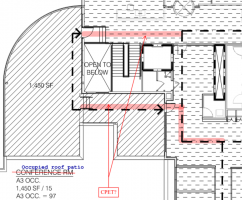In IBC 2015, is there a section similar to 1014.3 in IBC 2009 that gave a maximum common path of travel distance? I understand that Table 1006.2.1 (2015) combines occupant load/common path of travel to determine if a space could have only one exit where previously we had to look in two separate sections but is there still a section similar to the previous 1014.3 that defines the maximum common path of travel?
Or is this scenario possible:
B use occupancy space in a fully sprinklered building. Occupant load of 52 so per Table 1006.2.1, two exits or exit access doorways are required. So two doors out are provided and they comply with 1007 for configuration. From the most remote point in the space, I have to travel 100' before I reach the end of the common path to the two doors. Does this comply with 1006.2.1? If it does, it just seems counter-intuitive to safety. At least to me unless I'm missing something else. Thanks.
Or is this scenario possible:
B use occupancy space in a fully sprinklered building. Occupant load of 52 so per Table 1006.2.1, two exits or exit access doorways are required. So two doors out are provided and they comply with 1007 for configuration. From the most remote point in the space, I have to travel 100' before I reach the end of the common path to the two doors. Does this comply with 1006.2.1? If it does, it just seems counter-intuitive to safety. At least to me unless I'm missing something else. Thanks.

